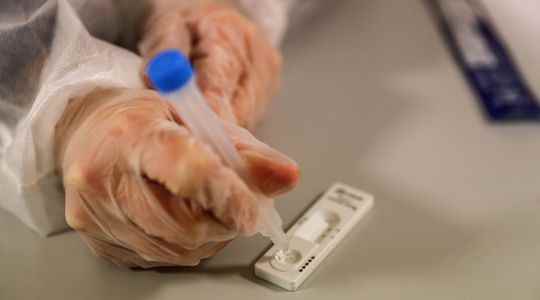On closer inspection, the curve of new daily Covid-19 contaminations has a very familiar profile. A line that has been rising, almost vertically for a few days and which confirms that Sars-CoV-2 has not disappeared. While on February 24, France reached a record peak of new cases, a month later and despite a rapid decline, the country is returning to the path of an epidemic runaway. Since the beginning of March, the circulation of the virus has experienced an ever greater acceleration in the territory, the incidence rate has continued to increase, gaining 36% compared to the previous week, and on Thursday March 24, the number of new recorded cases reached nearly 150,0000.
For nearly a month, it has been a sub-variant of Omicron which has been mainly responsible for this increase in cases. BA.2, a “cousin” of the BA.1 sub-variant which caused the very strong wave observed in January, is now the majority in France and represents more than 70% of new cases. The characteristics of Omicron, a more contagious virus, which strongly evades immunity conferred by previous infection or vaccination, gave it a considerable advantage over other variants. But this can also be explained by the ability of the virus to cause not only more contamination, but also faster.
The serial interval, a key datum
The speed of an outbreak depends on two factors: how many people each infected individual infects (called the basic reproduction number, or R0) and how long it takes for the virus to spread between two people. This second criterion is called “serial interval”, or serial interval, by epidemiologists. It has continuously declined since the start of the epidemic caused by the “historic” strain of the virus, discovered in Wuhan in China at the end of 2019.
Chinese researchers have thus shown that the Delta variant has a series interval of two days shorter than the historical strain, discovered in Wuhan. “Our results revealed that the time interval from exposure to the first positive PCR test in the quarantined population was six days during the 2020 outbreak and four days during the 2021 Delta outbreak,” write they in an article published in Nature.
With Omicron this interval has fallen even further, from 4.1 days with Delta to 3.7 days, according to data from the English health institutes. “Regarding Omicron, it has been proven that its advantage over Delta is not only linked to differences in serial interval time but, above all, to an ability to escape the immune response”, tempers Samuel Alizon, research director at the CNRS and specialist in the modeling of epidemics.
Faster variants win selection
While this advantage may not have been key to Omicron’s installation in France, it did stand out when the BA.2 sub-variant appeared. “With regard to BA.2 compared to BA.1, to date, effectively, the only documented difference appears to be a shorter serial interval, potentially associated with contagiousness starting sooner after infection,” says Samuel Alizon.
According to the data collected by the British health agency, the mean of the serial interval for BA.2 is about half a day shorter than BA.1. Thus, BA.2 has a series interval of 2.68 days against 3.27 days for BA.1. This would in particular give it a growth advantage over its “cousin” BA.1. “Our team and that of Simon Cauchemez estimate that this advantage is around 50%”, underlines Samuel Alizon.
How to explain this shorter duration between two symptomatic infections (what specialists call generation time)? “Selection for shorter generation times depends on transmission levels. When you have an epidemic that is going faster, you will have stronger selection for virus traits that have a shorter generation time,” explains François Blanquart. , researcher (CNRS) at the Interdisciplinary Center for Research in Biology, who directed a pre-publication study on the issue. In summary, the faster the epidemic spreads, the more the variants capable of rapidly infecting individuals will win over natural selection.
Towards more sudden waves?
These characteristics of the virus give it an advantage when the epidemic is growing, that is to say when an infected person infects more than one individual. But, as François Blanquart notes, “when the epidemic decreases and the reproduction rate of the virus drops below 1, a short generation time will lead to a faster decline in the epidemic”. Indeed, if an infected person is “contaminating” for less time, when the epidemic recedes, he is able to infect fewer people.
As a result, contamination peaks rise rapidly, but their decline is also faster. “We see it in the Netherlands, they are in epidemic decline after two contamination peaks. And the peak was 60% of the value of that of BA.2. We have a lower peak, and of a duration quite short and this can be seen as one of the effects derived from the decrease in the serial interval”, analyzes Antoine Flahault, epidemiologist at the Institute of Global Health in Geneva. It is clear that the Omicron variant does not cause a real epidemic plateau, a circulation of the virus at a high level, and relatively constant. “These are peaks, which the graphical representations show sharp, with a sharp descent.”
Does the BA.2 variant mean that we have to be prepared for more sudden waves? “We do not necessarily manage to understand what will be the result after BA.2, warns Antoine Flahault, but this drop in the interval makes the response more complex.” Will we have to return to certain barrier gestures during these peaks, or will we be able to escape an increase in hospitalizations following these epidemic returns? On Friday, health authorities noted that hospitalizations were no longer decreasing. In critical care services, the decline continued.
